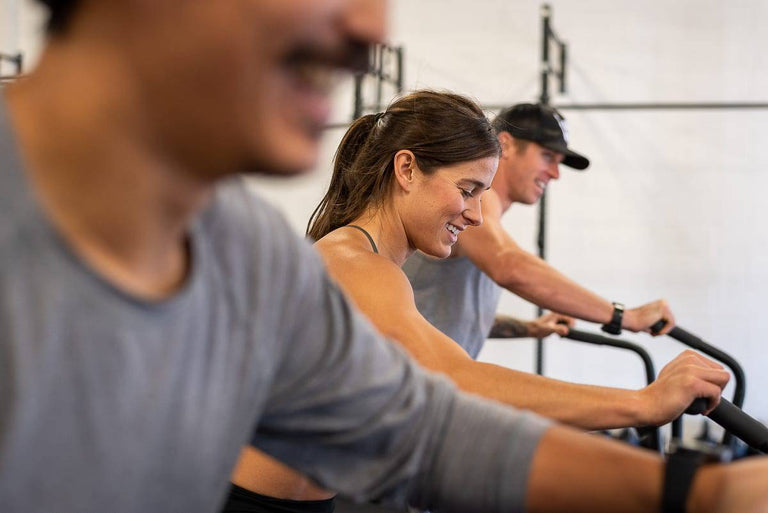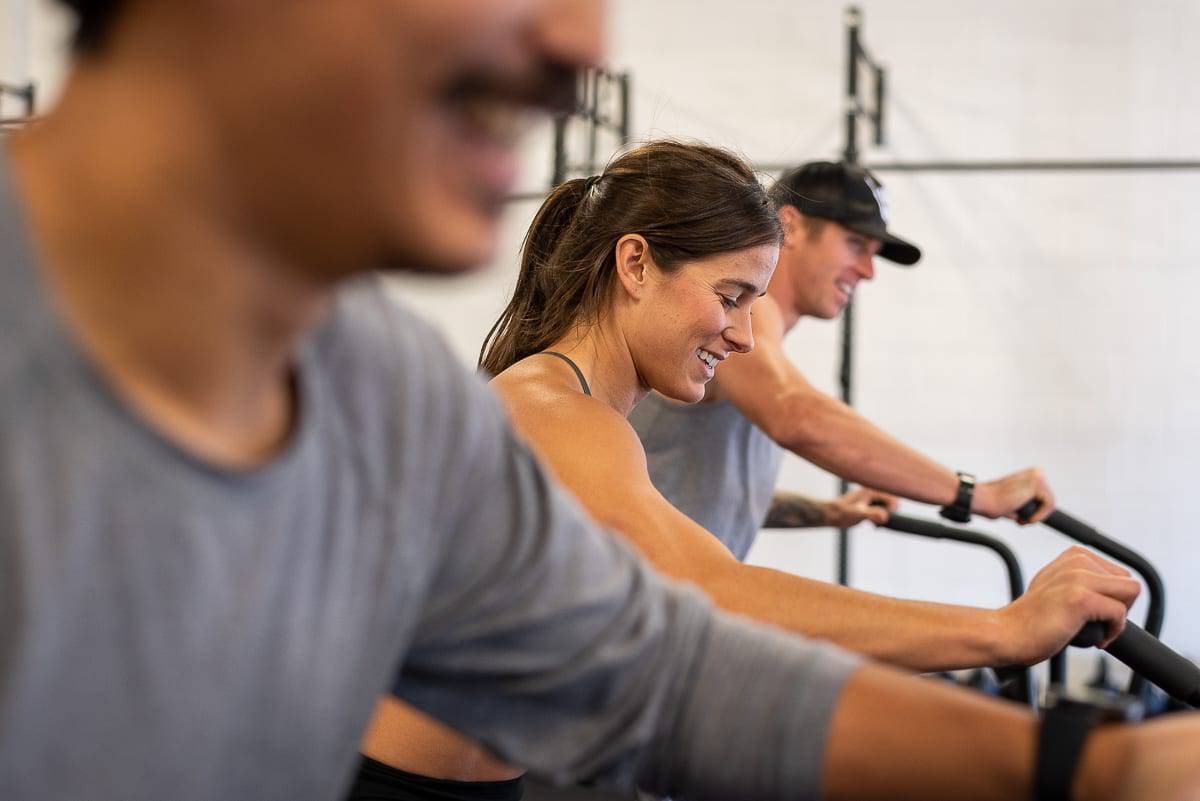Female physiology is undoubtedly complex. Hormone fluctuations throughout the monthly menstrual cycle are normal. But did you know that hormones can affect athletic performance?
There are two main phases in the menstrual cycle: the follicular phase (FP) and luteal phase (LP).1 The FP is the first phase. Generally, hormones (estrogen and progesterone) are low during the FP. By the middle of the FP, follicle stimulating hormone (FSH) increases, which causes estrogen levels to rise. When estrogen increases, luteinizing hormone (LH) surges, stimulating ovulation. Although not typically recognized as a defined “phase” during the menstrual cycle, the ovulatory phase is the short fertile window that occurs mid-cycle when estrogen increases and an egg is released from the ovary.2 After an egg is released, the LP begins and both progesterone and estrogen increase. Towards the end of the LP, hormones drop to stimulate menstruation, thus starting the cycle again.3,4 The LP lasts about 12-12.5 days, while the FP length can vary due to age, weight, ethnicity and lifestyle, which also affects the timing of ovulation.5

Men also naturally produce estrogen and progesterone but in much lower concentrations.6 Unfortunately, many of the studies about performance in sport have primarily used male test subjects. If women are included in studies, they are generally studied when their hormones are lower (i.e., the FP). However, this doesn’t help us understand why we may feel less powerful or energetic during different times of the month. As Dr. Stacy Sims says, “Women are not small men!”
Effects of Hormones on Aspects of Performance & Recovery
Hormones impact cardiovascular fitness, respiration, thermoregulation and metabolism.4 In the FP when hormone concentrations are low, carbohydrates are the primary fuel source utilized during moderate to high-intensity exercise.7,8 Amino acid breakdown is lower, which means that muscle is less likely to be catabolized for energy.9 During the mid-FP when estrogen increases, blood vessels widen and blood flow is improved, thus increasing cardiovascular fitness.10,11
Generally, the FP is associated with increased efficiency and performance due to lower hormone concentrations. Alternatively, performance diminishes when hormones are high during the LP. High progesterone concentrations cause core temperature and sweat threshold to increase, which reduces our ability to release heat from the body. Additionally, blood thickens and reduces cardiac output and oxygen consumption, thus reducing cardiorespiratory efficiency.10 Unlike the FP, carbohydrates are spared, which may result in amino acid breakdown at higher exercise intensities.12 However, more fat is utilized during the LP, which is an advantage in low-to-moderate intensity or endurance sports.3,9,7,8

Although the LP is largely associated with reduced performance, the ovulatory phase mid-cycle is connected to increased risk of injury. Injury risk increases when estrogen is at its peak. Specifically, the knee is prone to injury due to ligament stiffness and joint laxity caused by estrogen.6 As a result, women are 2-8 times more likely to experience anterior cruciate ligament (ACL) tears than men.13,14,15 These outcomes may be attributed to the effect of hormones on inhibition of collagen synthesis and wound healing.6 Additionally, muscle fatigability increases during ovulation, further enhancing injury risk to the knee.2
Of course, supplemental hormones, either from contraceptives or hormone replacement therapy, may contribute to altered performance, too, but their effects are less understood. Supplemental hormones may have similar effects as normal hormone fluctuations, probably because hormone concentrations in pills mimic the normal cycle. We need more studies, especially during performance events, to understand how hormones (natural or supplemental) affect performance.
Strategies for Performance: Nutrition and Lifestyle
Fortunately, there are ways to enhance performance, regardless of cycle timing. Generally, a well-balanced diet full of adequate calories, macronutrients (carbohydrates, fat and protein) and micronutrients (vitamins and minerals) supports normal hormone cycling and performance goals. It is especially important to consume a wholesome diet to ensure that detoxification pathways are functioning properly and can eliminate hormones. In order for the menstrual cycle to begin again, hormones must be eliminated from the body.
During the LP when hormones are highest, the best course of action is to consume more carbohydrates around training sessions and increase overall protein. Consuming a carbohydrate-rich snack in the one to two hours before training will help supply the body with ready-to-use fuel. To offset increased amino acid breakdown, protein high in essential/indispensable amino acids should be prioritized. High-quality protein includes eggs, whey or vegan protein powder, meat, tofu and dairy products. Branched-chain amino acids (BCAAs) consumed prior to exercise may also counteract protein degradation. Finally, to improve blood flow and reduce overheating during exercise, electrolyte supplements, such as Gnarly Hydrate, can enhance endurance capacity.
In addition to nutritional strategies, lifestyle modifications may support cyclical changes in hormones. Because the ovulatory phase is associated with increased risk of injury, intentional stretching and longer warm ups before training and may help support injury prevention. You might also consider consuming a collagen supplement, such as Gnarly Collagen Pro, before your training session to promote collagen synthesis. After ovulation, the high hormone LP may be an ideal time to increase rest and low-impact activities. Yoga, stretching, swimming and walking offer exercise without overwhelming the body. Performance goals can be met during the late LP, but you may notice a desire to reduce activity levels. Ultimately, listen to your body, understand its limits, and acknowledge when you need rest.
key takeaways
- When hormones are low in the FP, engage in exercise you enjoy and eat a well-balanced diet to support your activities.
- Although you may have lots of energy around ovulation, you may be more at risk of injury due to increased levels of estrogen. Listen to your body’s limits!
- During the LP when both progesterone and estrogen are high, recovery protocols should emphasize carbohydrates, protein and fluids.
- Consuming a carb-rich snack along with BCAAs prior to training sessions during the LP may counteract the carb-sparing and protein degradation effect.
- Sodium-loading through electrolyte powders may offset fluid handling disruptions in the LP.
- Tracking your cycle will provide more insights into how your performance is affected by hormone cycling. Only you can know what is best for your unique physiology!
works cited
- Martin, D., Sale, C., Cooper, S. B., & Elliott-Sale, K. J. (2018). Period Prevalence and Perceived Side Effects of Hormonal Contraceptive Use and the Menstrual Cycle in Elite Athletes. International Journal of Sports Physiology & Performance, 13(7), 926–932.
- Constantini, N. W., Dubnov, G., & Lebrun, M. (2005). The menstrual cycle and sport performance. Clin Sports Med, 24, e51-e82.
- Tarnopolsky, M. A., Bosman, M., MacDonald, J. R., Vandeputte, D., Martin, J., & Roy, B. D. (1997). Postexercise protein-carbohydrate and carbohydrate supplements increase muscle glycogen in men and women. Journal of Applied Physiology, 83(6), 1877–1883.
- Julian, R., Hecksteden, A., Fullagar, H. H. K., & Meyer, T. (2017). The effects of menstrual cycle phase on physical performance in female soccer players. Plos One, 12(3), e0173951.
- Bull, J. R., Rowland, S. P., Scherwitzl, E. B., Scherwitzl, R., Danielsson, K. G., & Harper, J. (2019). Real-world menstrual cycle characteristics of more than 600,000 menstrual cycles. NPJ Digital Medicine, 2, 83.
- Nicolay, C. W., Kenney, J. L., & Lucki, N. C. (2008). Grip strength and endurance throughout the menstrual cycle in eumenorrheic and women using oral contraceptives. International Journal of Industrial Ergonomics, 38(2), 211–221.
- Campbell, S. E., Angus, D. J., & Febbraio, M. A. (2001). Glucose kinetics and exercise performance during phases of the menstrual cycle: effect of glucose ingestion. American Journal of Physiology: Endocrinology & Metabolism, 44(4), E817.
- Zderic, T. W., Coggan, A. R., & Ruby, B. C. (2001). Glucose kinetics and substrate oxidation during exercise in the follicular and luteal phases. Journal Of Applied Physiology (Bethesda, Md.: 1985), 90(2), 447–453.
- Devries, M. C., Hamadeh, M. J., Phillips, S. M., & Tarnopolsky, M. A. (2006). Menstrual cycle phase and sex influence muscle glycogen utilization and glucose turnover during moderate-intensity endurance exercise. American Journal of Physiology: Regulatory, Integrative & Comparative Physiology, 291, R1120.
- Sims, S. T., Rehrer, N. J., Bell, M. L., & Cotter, J. D. (2007). Preexercise sodium loading aids fluid balance and endurance for women exercising in the heat. Journal of Applied Physiology, 103(2), 534.
- Sims, S. T., Rehrer, N. J., Bell, M. L., & Cotter, J. D. (2008). Endogenous and exogenous female sex hormones and renal electrolyte handling: effects of an acute sodium load on plasma volume at rest. Journal of Applied Physiology, 105(1), 121.
- Lamont, L. S., Lemon, P. W., & Bruot, B. C. (1987). Menstrual cycle and exercise effects on protein catabolism. Medicine And Science In Sports And Exercise, 19(2), 106–110.
- Lefevre, N., Bohu, Y., Klouche, S., Lecocq, J., & Herman, S. (2013). Anterior cruciate ligament tear during the menstrual cycle in female recreational skiers. Orthopaedics & Traumatology: Surgery & Research, 99, 572-575.
- Oliphant, J. G. & Drawbert, J. P. (1996). Gender differences in anterior cruciate ligament injury rates in Wisconsin intercollegiate basketball. J Athl Train, 31(3), 245-247.
15. Herzberg, S. D., Motu’apuaka, M. L., Lambert, W., Fu, E., Brady, J., & Guise, J.-M. (2017). The effect of menstrual cycle and contraceptives on ACL injuries and laxity. The Orthopaedic Journal of Sports Medicine, 5(7).






